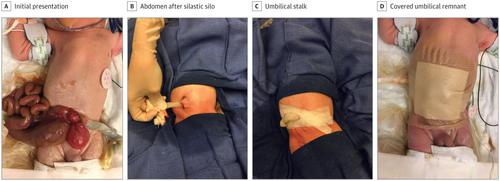JAMA Surgery ( IF 16.9 ) Pub Date : 2019-01-01 , DOI: 10.1001/jamasurg.2018.3216 Russell G. Witt 1 , Michael Zobel 1 , Benjamin Padilla 1 , Hanmin Lee 1 , Tippi C. MacKenzie 1 , Lan Vu 1

|
Importance Sutureless gastroschisis repair offers an alternative to the traditional sutured method and has been associated with decreased intubation time. Published study results are inconsistent regarding the advantages of sutureless closure.
Objective To compare the clinical outcomes of sutureless and sutured gastroschisis repair.
Design, Setting, and Participants A single-center cohort review was performed of all consecutive patients (n = 97) who underwent gastroschisis repair from February 1, 2007, to April 30, 2017, at the University of California, San Francisco. Patients’ medical records were evaluated for clinical characteristics and outcomes. Cases with incomplete data during initial hospitalization were excluded.
Main Outcomes and Measures Length of hospital stay, time to full enteral feeds, total parenteral nutrition duration, days requiring intravenous analgesia, days intubated, wound infection rate, antibiotic treatment duration, rate of umbilical hernias that required an operation, and readmission rate.
Results In total, 97 patients (47 [48%] were female and 50 [52%] were male with a mean [SD] age of 2.8 [2.8] days) underwent gastroschisis repair, of which 7 were excluded for incomplete medical record. Of the 90 patients included in the study, 50 (56%) underwent sutured closure and 40 (44%) underwent sutureless closure. No statistical difference was found between the sutured and sutureless groups in length of hospital stay (mean [SD] days, 43.9 [40.4] vs 36.7 [21.2]; P = .71), time to full enteral feeds (mean [SD] days, 31.4 [20.2] vs 27.9 [17.3]; P = .22), total parenteral nutrition duration (mean [SD] days, 33.5 [29.8] vs 27.4 [18.2]; P = .23), wound infection rates (14 [28%] vs 10 [25%]; P = .81), and readmission rates (5 [10%] vs 7 [18%]; P = .36). The sutureless group, compared with the sutured group, had substantially fewer days receiving antibiotics (mean [SD], 7.2 [6.4] vs 12.4 [13.2]; P = .003), fewer days intubated (mean [SD], 2.8 [3.3] vs 6.8 [1.3]; P = .001), fewer days receiving intravenous analgesia (mean [SD], 4.2 [4.0] vs 7.1 [4.5]; P = .003), and fewer patients that required silo reduction (25 [63%] vs 48 [96%]; P < .001). Sutureless closures, compared with the sutured technique, had considerably more umbilical hernias requiring surgical repair (5 [13%] vs 0; P = .02).
Conclusions and Relevance Sutureless repair of gastroschisis appears to be associated with a statistically significant reduction in mechanical ventilation duration and pain medication requirements but may increase umbilical hernia risk. Multicenter randomized clinical trials are necessary to determine the true advantages of the sutureless approach.
中文翻译:

无缝缝合与缝合缝合技术在胃chi裂修复术中的临床效果评估
重要性 无缝线胃瘘修补术是传统缝合方法的替代方法,并且与减少插管时间有关。关于无缝合闭合的优势,已发表的研究结果不一致。
目的 比较无缝合和缝合型胃气管修补术的临床效果。
设计,设置和参加者 从2007年2月1日至2017年4月30日在加利福尼亚大学旧金山分校进行胃chi虫病修补的所有连续患者(n = 97)进行了单中心队列研究。对患者的病历进行了临床特征和预后评估。首次住院期间数据不完整的病例被排除在外。
主要结果和措施 住院时间,完全肠内进食的时间,总肠胃外营养时间,需要静脉镇痛的天数,插管天数,伤口感染率,抗生素治疗时间,需要手术的脐疝的发生率和再入院率。
结果 总共有97例患者接受了胃气管修补术(其中47例[48%]为女性,50例[52%]为男性,平均[SD]年龄为2.8 [2.8]天),其中7例因病历不完整而被排除在外。在研究中包括的90名患者中,有50名(56%)进行了缝合缝合,而40名(44%)进行了无缝合缝合。缝合组和无缝合组之间的住院时间(平均[SD]天,43.9 [40.4] vs 36.7 [21.2];P = .71),完全肠内喂养的时间(平均[SD]天)没有发现统计学差异。, 肠外营养总持续时间(平均[SD]天,33.5 [29.8] vs 27.4 [18.2];P = 0.23),伤口感染率(31.4 [20.2]对27.9 [17.3];P = 0.22);P = 0.22)(14 [ 28%]和10 [25%];P = 0.81)和再入院率(5 [10%]对7 [18%];P = 0.36)。与缝合组相比,无缝合组接受抗生素的天数明显减少(平均[SD],7.2 [6.4]比12.4 [13.2];P = .003),插管天数更少(平均[SD],2.8 [3.3] ] vs 6.8 [1.3];P = .001),接受静脉镇痛的天数减少(平均[SD],4.2 [4.0] vs 7.1 [4.5];P = .003),需要减少筒仓的患者更少(25 [ 63%)对48 [96%];P <.001)。与缝合技术相比,无缝合闭合术的脐疝要手术修复的多得多(5 [13%] vs 0; P = .02)。
结论与相关性 缝线虫病的无缝合修复似乎与机械通气时间和止痛药物需求的统计显着减少有关,但可能会增加脐疝的风险。为了确定无缝合方法的真正优势,必须进行多中心随机临床试验。


























 京公网安备 11010802027423号
京公网安备 11010802027423号